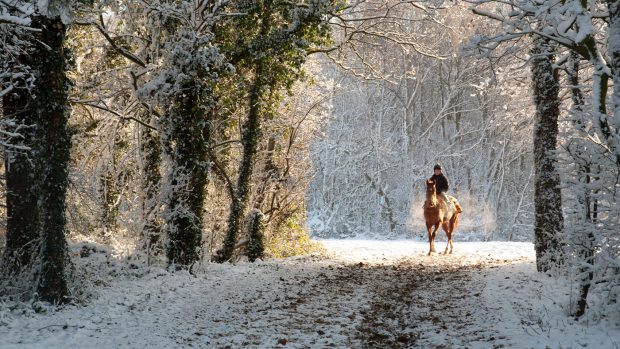Few horse owners can honestly say they look forward to the winter months. Although there are upsides such as hunting, enjoying a hack in the winter sun and seeing your horse tucked up in a deep and cosy bed, the short days combined with wet and cold weather can make doing horses a chore.
But as a wise old horseman once said: “there is no such thing as bad weather, only the wrong clothing”, so here is our guide to the items you need in your wardrobe to make winter that bit easier this year.
Winter clothing essentials
A long (at least knee-length) padded winter coat, preferably with a fur-lined hood, which is warm enough to keep out the Arctic chill that can be found in most indoor (and outdoor) schools. Essential if you spend time teaching, watching or hanging around at shows between classes. If it can be cut to avoid making the wearer resemble an Egyptian mummy, then all the better.
A pair of waterproof knee-high yard boots, such as neoprene-lined wellies, will help you to avoid the complete loss of feeling in your toes while busy on the yard. Ones that are designed for riding in and can be simply rinsed off before you jump in the saddle are time-saving as well.
While boots are important, the right pair of socks can make the difference between toasty toes and painful feet. There are a wide range of thermal socks available in a variety of thicknesses. Make sure your toes have room to move inside your boots as socks that are too thick can have the opposite effect to the one desired.
Continued below…
Win one of two £100 vouchers with Country & Stable
Do you fancy a new pair of Le Chameau boots or a cosy winter jumper? Enter an ‘Elfie’ with Country & Stable for your chance to win one of two £100 vouchers. To find out how to enter, click here. Competition closes on Sunday 21 December. |
A robust pair of winter breeches, preferably with a water-resistant outer and fleece inner. My personal preference is for a full seat (to help keep me in the saddle when exercising sharp horses on a chilly morning) and stretch ankles rather than Velcro adjustment. Warmth wins over appearance here and a pair with a bit of room will allow a warm layer of air between your leg and the breeches, or allow for a pair of thermal leggings underneath, so don’t go for a skin tight cut.
As mentioned above, a pair of thermal leggings can prove a godsend in the fight against chilblains. Both tights (with foot) and leggings (without foot) are available, with some having double thickness over the thighs to help keep these at-risk areas warm. A pair of waterproof over-trousers can also be added in extreme conditions.
When it comes to keeping your torso comfortable, thinner layers is are definitely the way to go. Thermal base layer tops should be long enough to tuck into your breeches and not pull out to leave a draft up your back when you are crouching down to fit brushing boots or doing other important tasks. They should also wick away moisture so you don’t end up feeling clammy and damp.
This can be topped with a fairly close fitting jumper, preferably with a polo neck, in a warm material of your choice (natural fibres allow the skin to breathe). Depending on the conditions, a down-filled gilet, fleece jacket or waterproof coat will keep you warm and dry. It’s important that the items aren’t so bulky that they prevent you from moving around easily.
Your waterproof coat should be suitable for both riding and wearing around the yard. Length can vary from around the hips to just above the knee, but it should have a rear vent that you can open to make it comfortable in the saddle, plus a two-way zip. Pockets should be able to be fastened so you can keep keys and your phone safe, and if it also has open hand-warmer pockets (preferably fleece-lined) then all the better.
Keeping your head and neck warm is a great way to help maintain your body temperature. Some riders chose a thin balaclava that they can wear under your their riding hat, but most of the H&H office vote for the clip-on ear muffs that attach to the harness on your hat to avoid ear ache when riding on frosty mornings. Neck muffs are also a useful addition as they don’t become unravelled and get in the way like scarfs can.
Gloves are a personal choice. Some people like the fastening on the back of the hand, some around the wrist. Some prefer a thicker, robust glove for winter like those used for skiing, while others prefer a thinner glove which allows them to do tasks like tacking up without taking the gloves off, although they offer less warmth overall. Whatever your preference, I would recommend you have multiple pairs, as there is nothing worse than not being able to find them when you need them! With a pair of robust waterproof gloves for yard work, a slightly thinner but still warm pair for riding, a pair of silk glove liners and some reusable gel hand warmers, you should be prepared for every eventuality.
Do you agree with our suggestions? Is there something you think we should add? Please use the comments facility down the page to let us know…





